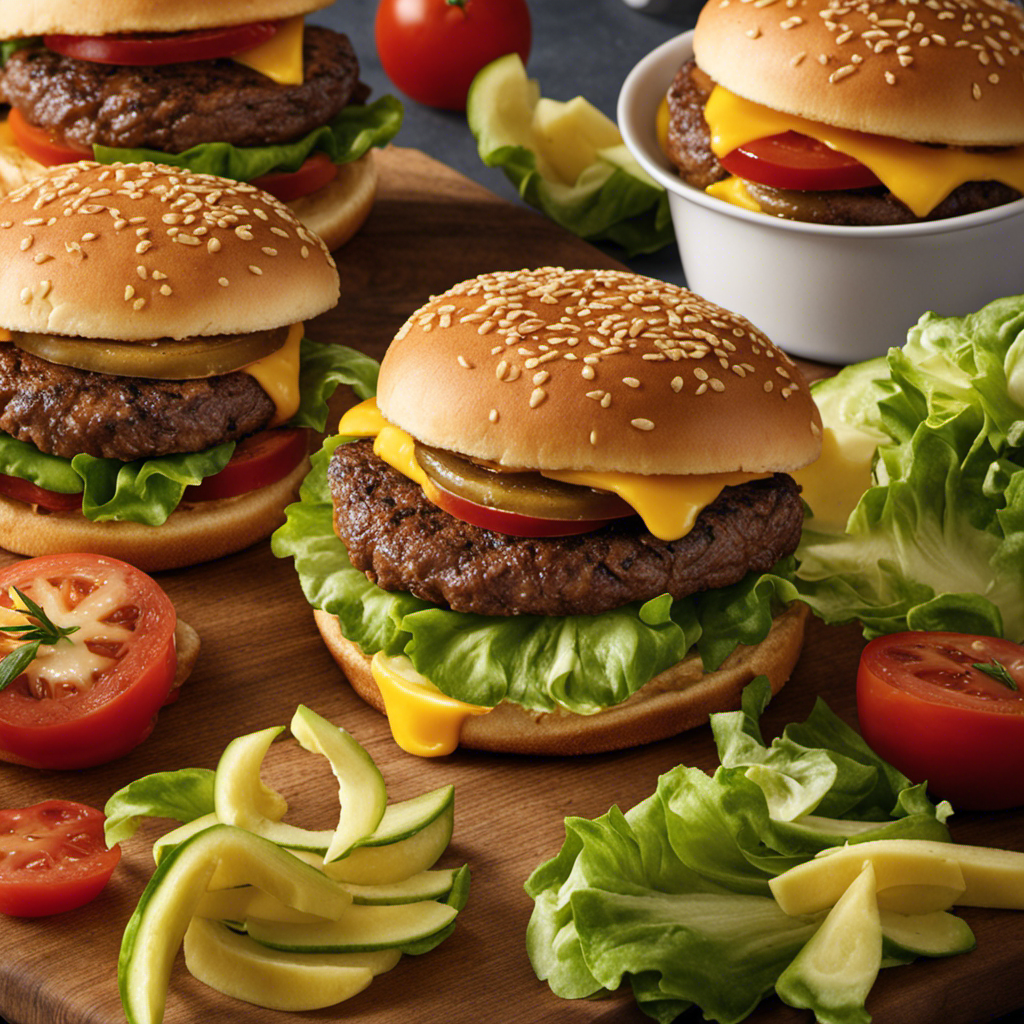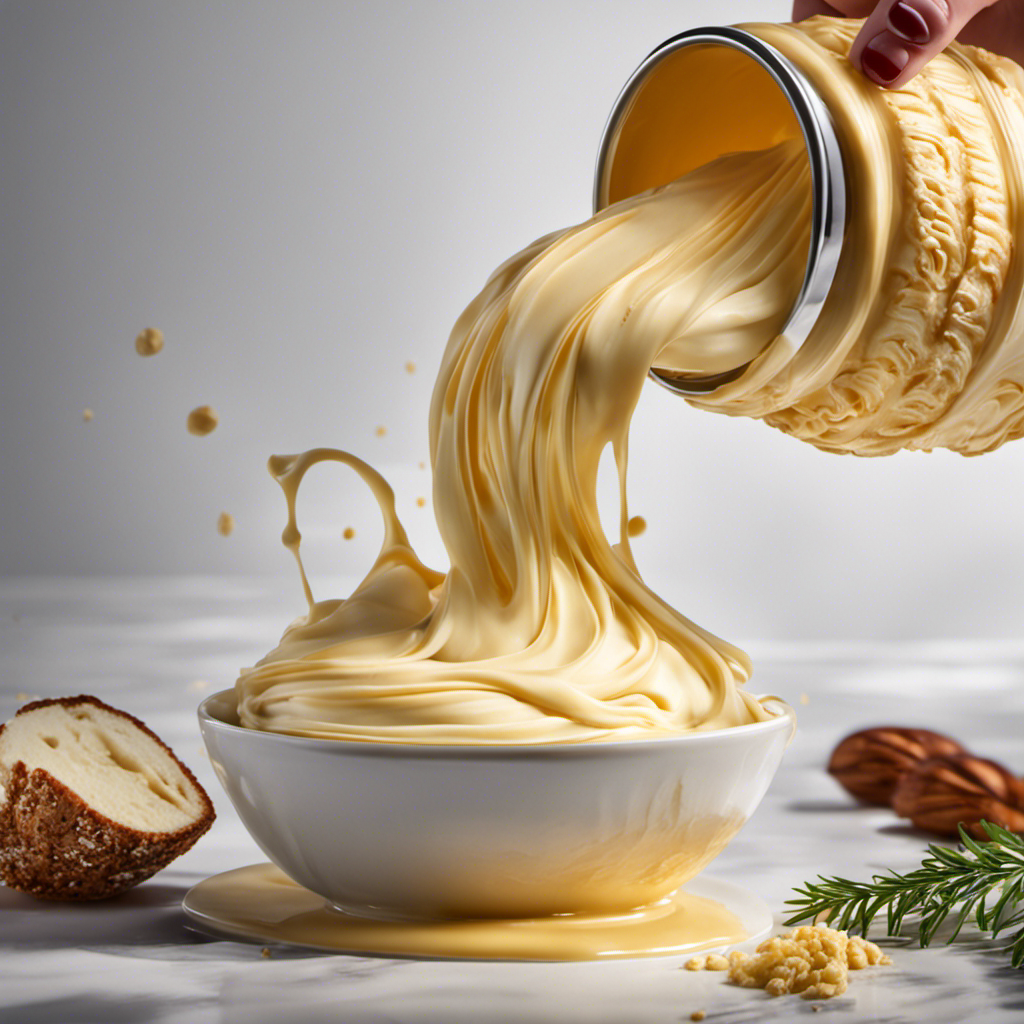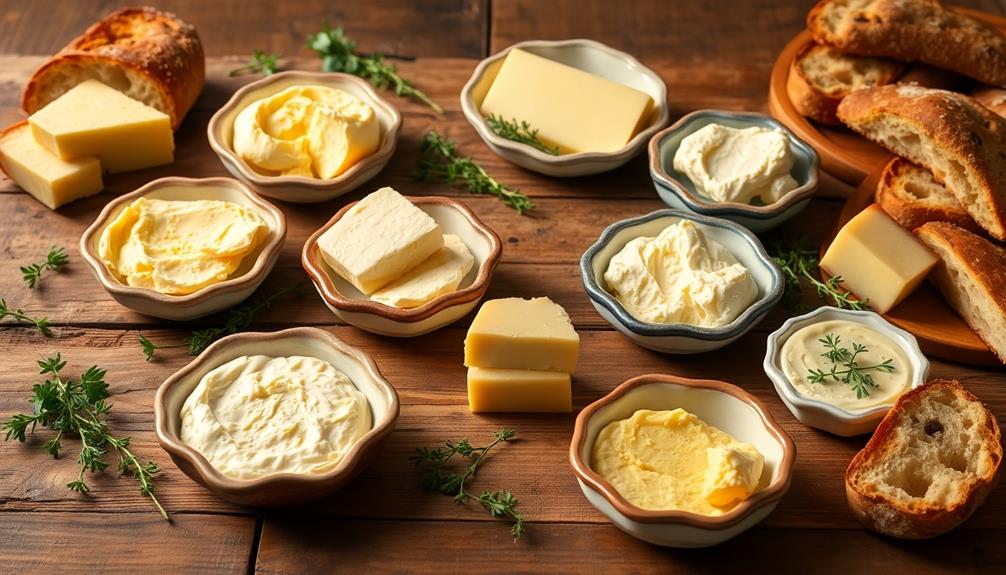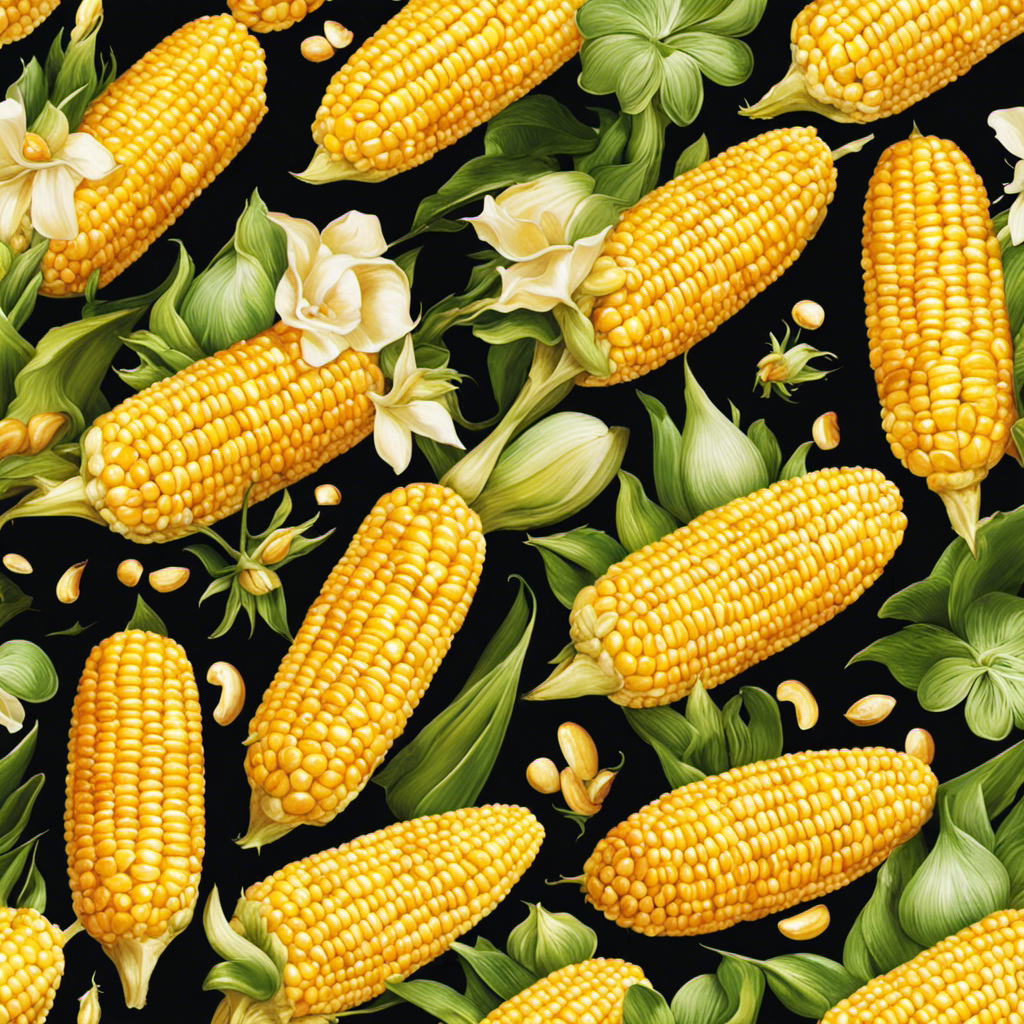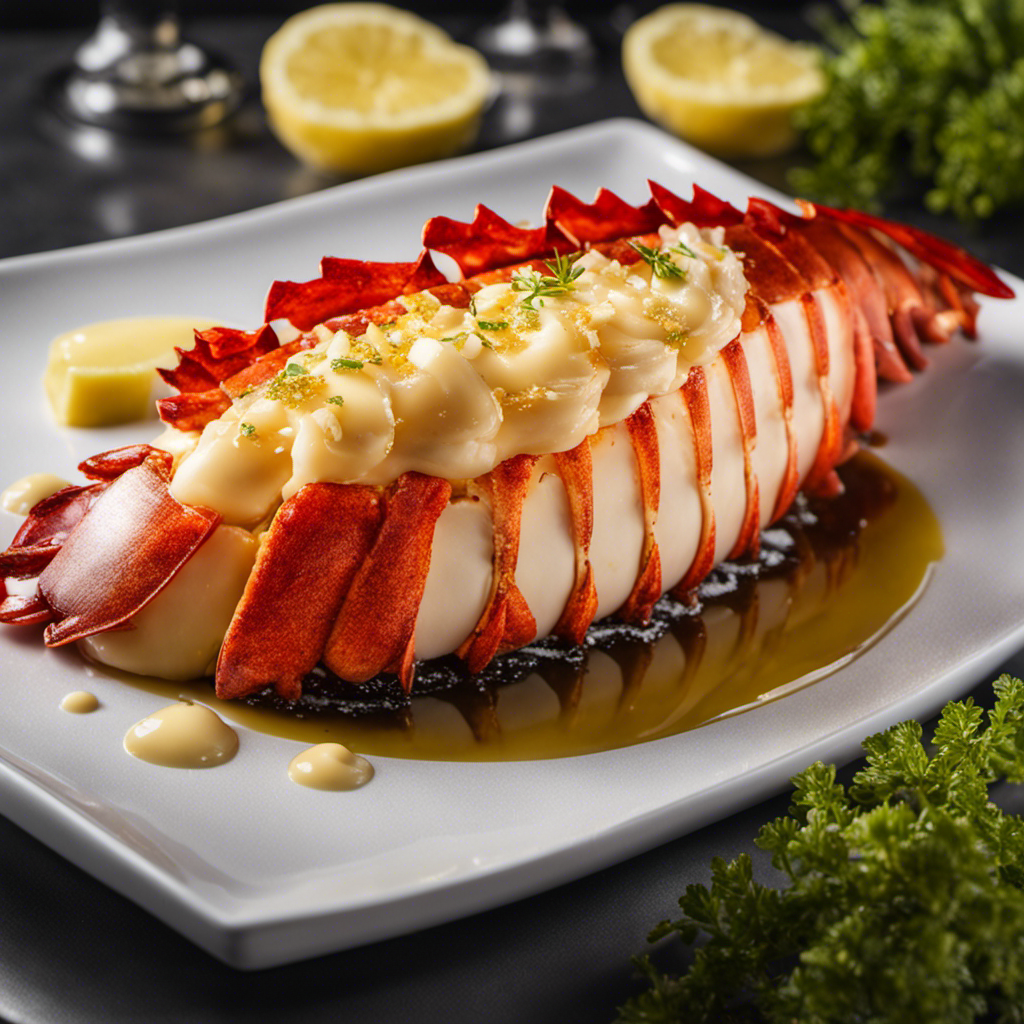I’ve often pondered over the exact number of tablespoons of butter that are equivalent to 3/4 cup. This inquiry might arise while you’re attempting to adhere to a recipe or seeking to make accurate measurements while cooking.
Well, I’ve got good news – I’ve done the research and I’ve got the answer for you. In this article, I’ll be diving into the world of butter measurements, explaining how to convert cups to tablespoons, and breaking down the exact measurements for 3/4 cup of butter.
So, let’s get started and demystify the world of butter conversions!
Key Takeaways
- 3/4 cup of butter is equivalent to 12 tablespoons.
- Converting butter measurements can be tricky, but knowing the equivalents makes it easier.
- Accurate measurements are crucial for precise cooking and baking.
- Using a measuring cup designed for butter or a kitchen scale can eliminate guesswork and ensure accuracy.
Understanding Butter Measurements
To understand butter measurements, it’s important to know how many tablespoons of butter equal 3/4 cup. Converting butter measurements can be tricky, but once you understand the butter measurement equivalents, it becomes much easier.
When it comes to butter, 1 cup is equal to 16 tablespoons. So, to find out how many tablespoons are in 3/4 cup of butter, we can simply multiply 16 by 3/4. This gives us 12 tablespoons. Therefore, 3/4 cup of butter is equivalent to 12 tablespoons.
Knowing these conversions can be helpful when following recipes or adjusting measurements. It ensures accuracy and allows for precise and scientific cooking or baking. So, keep this conversion in mind the next time you’re working with butter.
Converting Cups to Tablespoons
When it comes to butter measurement conversions, accuracy is key.
In this discussion, I will explore the precise measurements needed to convert cups of butter to tablespoons.
It is important to understand the accuracy of tablespoon measurements in order to ensure the correct amount of butter is used in recipes.
Butter Measurement Conversions
There’s no exact answer to how many tablespoons of butter equals 3/4 cup, but typically it is around 12 tablespoons.
Understanding butter ratios can help achieve precise measurements in recipes.
When it comes to measuring butter, it’s important to use the proper technique to ensure accuracy.
One helpful tip is to use a measuring cup specifically designed for butter, which often has markings for tablespoons.
Another method is to use a kitchen scale to weigh the butter, as this eliminates any guesswork.
Softened butter can also be measured by using the displacement method. Fill a liquid measuring cup with water and then add the butter until the water level increases to the desired amount.
Accuracy of Tablespoon Measurements
Using a measuring cup designed for butter can help ensure accurate tablespoon measurements. As a cook, I have come to understand the importance of precise measurements when it comes to baking and cooking. Here are three reasons why understanding tablespoon accuracy is crucial:
-
Consistency: Accurate tablespoon measurements ensure that the same amount of ingredient is used every time, resulting in consistent taste and texture in your recipes.
-
Recipe Success: Precise measurements are vital for achieving the desired outcome in your dishes. Too much or too little butter can significantly affect the final result.
-
Nutritional Information: Understanding tablespoon accuracy allows you to accurately track the nutritional content of your recipes. This is particularly important for individuals with specific dietary requirements or health concerns.
The Basic Butter-to-Cup Ratio
The basic ratio is that 1 cup of butter is equivalent to 16 tablespoons. Understanding butter equivalents is crucial for accurate measurements in baking and cooking. To help you visualize the conversions, here’s a handy table:
| Cups of Butter | Tablespoons |
|---|---|
| 1 cup | 16 tbsp |
| 3/4 cup | 12 tbsp |
| 1/2 cup | 8 tbsp |
| 1/4 cup | 4 tbsp |
When measuring butter, it’s important to be precise. To ensure accuracy, use a measuring cup specifically designed for liquids or look for markings on the butter packaging. Soften the butter to room temperature before measuring, as this will make it easier to get an accurate amount. Now, let’s move on to breaking down 3/4 cup of butter and explore more about measuring butter accurately.
Breaking Down 3/4 Cup of Butter
To break down 3/4 cup of butter accurately, you’ll need to measure out 12 tablespoons. Understanding butter substitutes and different butter packaging sizes can be helpful in cooking and baking. Here are three key points to consider:
-
Butter Substitutes: In some recipes, you may want to use a butter substitute like margarine or vegetable oil. Understanding the ratio to convert butter to these substitutes is crucial for achieving the desired results.
-
Different Packaging Sizes: Butter is commonly sold in sticks or blocks, and the packaging size may vary. Knowing the weight or volume of each package will help you determine the number of tablespoons in a specific quantity.
-
Precision Matters: When it comes to baking or cooking, precision is important. Using the accurate measurement of 12 tablespoons for 3/4 cup of butter ensures that your recipe turns out just right.
By understanding butter substitutes and different packaging sizes, you can confidently calculate tablespoons in a cup of butter and make precise measurements for your culinary creations.
Now, let’s dive into the process of calculating tablespoons in a cup of butter.
Calculating Tablespoons in a Cup of Butter
When calculating the amount of butter in a cup, you’ll need to know how many tablespoons are in that measurement. Understanding butter equivalencies is essential to ensure accurate measurements in recipes. Common misconceptions about butter measurements can lead to incorrect proportions and affect the outcome of your dish.
In the case of butter, there are 16 tablespoons in a cup. This means that if a recipe calls for 3/4 cup of butter, you would need 12 tablespoons.
It’s important to note that butter is typically sold in sticks, with each stick measuring 1/2 cup or 8 tablespoons. So, to measure 3/4 cup of butter, you would need 1 and 1/2 sticks.
The Math Behind Butter Conversions
Understanding the math behind butter conversions is crucial for accurately measuring ingredients in recipes. Converting butter measurements can be a bit tricky, but with the right knowledge, it becomes much easier. Here are three key points to help you understand butter equivalents and convert measurements effectively:
-
Butter is typically measured in cups, tablespoons, and grams. Each measurement unit has its own conversion factor, and knowing these factors is essential for precise measurements.
-
To convert butter from cups to tablespoons, multiply the number of cups by 16. For example, if you have 1 cup of butter, it would be equivalent to 16 tablespoons.
-
It’s important to note that butter density can vary, especially if it’s melted or at room temperature. This can affect the accuracy of your measurements, so it’s best to follow a trusted recipe or use a kitchen scale for more precise results.
Understanding butter equivalents and converting butter measurements will ensure that your recipes turn out just right. Now, let’s delve into measuring butter in tablespoons.
Measuring Butter in Tablespoons
Measuring butter in tablespoons can be a convenient way to accurately portion it for recipes. However, if you need to convert these measurements to grams or ounces, it’s important to know the conversions.
One tablespoon of butter is equal to approximately 14 grams or 0.5 ounces. This conversion is useful when following recipes that require precise measurements.
To convert butter measurements to grams, simply multiply the number of tablespoons by 14. For example, if a recipe calls for 4 tablespoons of butter, you would multiply 4 by 14 to get 56 grams.
Similarly, to convert to ounces, multiply the number of tablespoons by 0.5. So, 4 tablespoons of butter would be equal to 2 ounces.
Understanding these conversions can help ensure accurate and consistent results in your culinary endeavors.
How to Measure 3/4 Cup of Butter
When it comes to measuring butter, it’s important to understand the conversion ratios and alternative methods available. Conversion ratios help determine the amount of butter needed when a recipe calls for a specific measurement in a different unit.
Alternative methods, on the other hand, provide options for measuring butter without relying solely on volume measurements. This discussion will delve into these key points, providing a scientific and informative perspective on how to accurately measure butter in various scenarios.
Conversion Ratios for Butter
To convert cups to tablespoons of butter, you’ll need to know the conversion ratios. Understanding butter ratios is crucial for accurate measurements in recipes. Here are the steps to convert butter measurements:
-
Know the conversion ratio: There are 16 tablespoons in 1 cup of butter. This means that for every cup of butter, there are 16 tablespoons.
-
Determine the amount of butter: If you have 3/4 cup of butter, you can multiply it by the conversion ratio to find the equivalent in tablespoons. In this case, 3/4 cup x 16 tablespoons/cup = 12 tablespoons.
-
Use the converted measurement: Once you have converted the butter measurement to tablespoons, you can use it in your recipe accordingly.
Understanding butter ratios and converting butter measurements accurately is essential for achieving the desired results in your cooking and baking endeavors.
Alternative Methods for Measuring
Now that we know the conversion ratios for butter, let’s explore alternative methods for measuring it.
While using measuring spoons and cups is the most common way to measure butter, there are other precise methods available.
One alternative method is using a kitchen scale. This allows you to measure the exact weight of butter required for your recipe, ensuring accurate results.
Another option is using butter wrappers, which often have measurements marked on them. These measurements can guide you in cutting the right amount of butter from a stick.
Additionally, some butter brands offer pre-measured sticks, each representing a specific quantity. These alternative methods can be particularly useful when precise measurements are crucial for the success of your recipe.
Handy Butter Conversion Chart
If you’re wondering about the equivalent measurements, you can use a handy butter conversion chart to find out how many tablespoons of butter equal 3/4 cup. Understanding butter equivalents and converting butter in recipes is essential for accurate measurements in cooking and baking. Here are three key points to consider:
-
Standard Conversion: 1 cup of butter is equal to 16 tablespoons. Therefore, 3/4 cup of butter would be equivalent to 12 tablespoons.
-
Scaling Down: If you need less than 3/4 cup of butter, you can use the following conversion: 1/4 cup of butter is equal to 4 tablespoons. So, for 1/2 cup of butter, you would need 8 tablespoons.
-
Scaling Up: On the other hand, if you need more than 3/4 cup of butter, you can multiply the tablespoon measurement accordingly. For example, 1 cup of butter would be equivalent to 16 tablespoons, while 1 1/2 cups of butter would be equal to 24 tablespoons.
Tips for Accurate Butter Measurements
When it comes to baking and cooking, precise measurements are crucial. This is especially true when it comes to butter. Understanding butter measurement conversions is essential for ensuring accurate results in your recipes.
In this discussion, I will share some tips and techniques to help you achieve precise butter measurements every time. This will allow you to confidently create delicious dishes.
Butter Measurement Conversions
To convert 3/4 cup of butter to tablespoons, you’ll need 12 tablespoons.
When it comes to baking, understanding butter substitutions and using the right measurements is crucial. Here are some tips for baking with butter:
-
Use unsalted butter: This allows you to control the amount of salt in your recipe.
-
Room temperature butter: Most recipes call for softened butter, as it blends more easily with other ingredients.
-
Clarified butter: If you’re looking for a substitute with a higher smoke point, clarified butter can be a great option.
Ensuring Precise Butter Measurements
Remember, it’s important to be precise with your measurements when working with butter in baking. Accurate measurements can make all the difference in the outcome of your baked goods. To help you achieve precise butter measurements, here are some alternative measuring techniques you can use:
| Measurement | Amount |
|---|---|
| 1 stick | 1/2 cup |
| 1/2 stick | 1/4 cup |
| 1/4 stick | 1/8 cup |
Using these measurements can help you accurately measure butter when a recipe calls for a specific amount in cups. It’s crucial to follow the recipe’s instructions precisely to ensure the desired texture and taste of your baked goods. So, next time you’re baking, remember to rely on these alternative measuring techniques and prioritize the importance of accurate measurements in your baking process.
Common Mistakes in Butter Conversion
You might want to avoid using too many contractions in formal writing. When it comes to understanding butter equivalents and converting them accurately, there are some common errors that people often make.
Here are three key mistakes to watch out for:
-
Using volume measurements instead of weight: Butter is often measured in cups or tablespoons, but these measurements can vary depending on the density of the butter. It’s best to use weight measurements, such as grams or ounces, for more precise conversions.
-
Ignoring the difference between salted and unsalted butter: Salted butter contains added salt, which can affect the taste and texture of your recipe. Make sure to adjust the amount of salt in your recipe accordingly when using salted butter.
-
Not considering the temperature of the butter: Recipes may specify if the butter should be melted, softened, or chilled. Using the wrong temperature can affect the outcome of your recipe, so be sure to follow the instructions carefully.
Frequently Asked Questions
Can I Use Margarine Instead of Butter in This Conversion?
Yes, margarine can be used instead of butter in this conversion. However, it’s important to consider taste preference as margarine has a different flavor profile. Experiment to find what works best for you.
How Can I Convert Tablespoons of Butter to Grams or Ounces?
Converting butter measurements can be a bit tricky. To convert tablespoons of butter to grams or ounces, you’ll need to know the density of the butter. It’s a precise and scientific process.
What Is the Difference Between Salted and Unsalted Butter in Terms of Measuring and Conversions?
When measuring butter for baking, it’s important to know the differences between salted and unsalted butter. The amount of tablespoons in 3/4 cup can vary depending on the type of butter used.
Are There Any Special Considerations When Measuring Butter for Baking Recipes?
When measuring butter for baking, it’s important to consider the desired texture and flavor. Substituting butter in recipes requires careful measurement to achieve the right balance. Here are some tips for accurate measuring.
Can I Use a Kitchen Scale to Measure Butter Instead of Using Tablespoons or Cups?
Using a kitchen scale to measure butter is a precise method. However, using tablespoons or cups offers more convenience and is commonly used in baking recipes. The benefits of both methods depend on personal preference and the recipe requirements.
Conclusion
In conclusion, it is important to understand butter measurements and how to convert them accurately.
By knowing the basic butter-to-cup ratio and breaking down the measurement, we can easily calculate that 3/4 cup of butter is equal to 12 tablespoons.
Using a handy butter conversion chart and following tips for accurate measurements, we can ensure our recipes turn out perfectly.
Remember, as the saying goes, ‘A watched pot never boils,’ so take your time and measure your butter precisely for delicious results.

